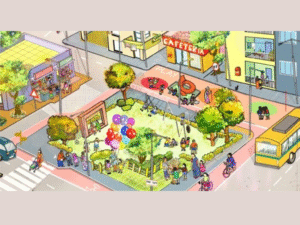Since childhood, I’ve been drawn to exploration, not just of places but of the stories and cultures within them. Inspired by Satyajit Ray’s Tarinicharan Banerjee, who chased meaning across 60 cities and 38 jobs, I’ve embraced curiosity as my compass.
As I travelled across India, however, a troubling pattern emerged—women everywhere lived with a quiet, constant sense of insecurity. This reality became stark in Gurgaon, a city that represents India’s economic rise but also reflects a widening gender safety gap. In 2024, 1,727 crimes against women were reported here, up from just 86 in 2016.
As a U-CAN Fellow with Safetipin, I gained insight into Gurgaon’s stark contradictions. Safetipin supports the city police in their efforts to improve women’s safety, grounded in the belief that safety isn’t just about infrastructure. Real change requires confronting deep-rooted patriarchal norms. While more patrolling helps, lasting transformation depends on shifting societal attitudes toward gender equality.
These attitudes may vary across regions but often lead to similar outcomes. Consider Bengal, my home state. Female literacy (77%) and sex ratios (951 women per 1,000 men) are higher than Haryana’s (69% and 893, respectively). Yet in 2022, Bengal recorded over 33,000 crimes against women. This shows that safety isn’t a regional issue; it’s a national failure.
The core of the problem lies in outdated gender roles that persist across much of India. Women are often confined to traditional duties, while men are expected to be the sole providers. But equality is ultimately about offering choice—the freedom for everyone, regardless of gender, to define their roles without societal pressure.
In this context, social media has become a powerful tool for women to voice their concerns and demand accountability. As of 2024, India has 1.4 billion mobile phone connections and 806 million internet users. Of these, 34% are women, many of whom are increasingly using digital platforms for self-expression, activism, and access to information. In Gurgaon and beyond, women are challenging norms, sharing stories, and advocating for their rights. This digital empowerment is a step forward, though changing deeply entrenched beliefs will take time. True equality means not just protection but respect for CEOs, rickshaw drivers, and everyone in between.
The path forward must be collective. Men, too, need freedom from the pressure of traditional expectations. In India, 58% of men still believe they should be the primary breadwinners, revealing how heavily these roles weigh on them. Meanwhile, women continue to be constrained by societal norms, with only 27% of urban women in the labour force compared to 80% in rural areas.
Equality is not just about closing a gap; it’s about enabling choice—whether it’s men expressing vulnerability or women taking on leadership. Everyone deserves the freedom to shape their own path based on personal aspirations rather than outdated roles. Only then can we move closer to genuine equality.
Gurgaon, with its towering skyline and ongoing reports of harassment, is a microcosm of India’s paradox: rapid development set against persistent gender inequality. Its future must be built not just on infrastructure but also on compassion, awareness, and systemic reform. We must create a city where women can truly thrive.
In my next article, I’ll explore the underlying patterns behind rising crimes against women, looking into the socio-cultural, economic, and psychological factors that fuel harassment and violence. This will help us better understand and address the root causes of gender-based injustice.


